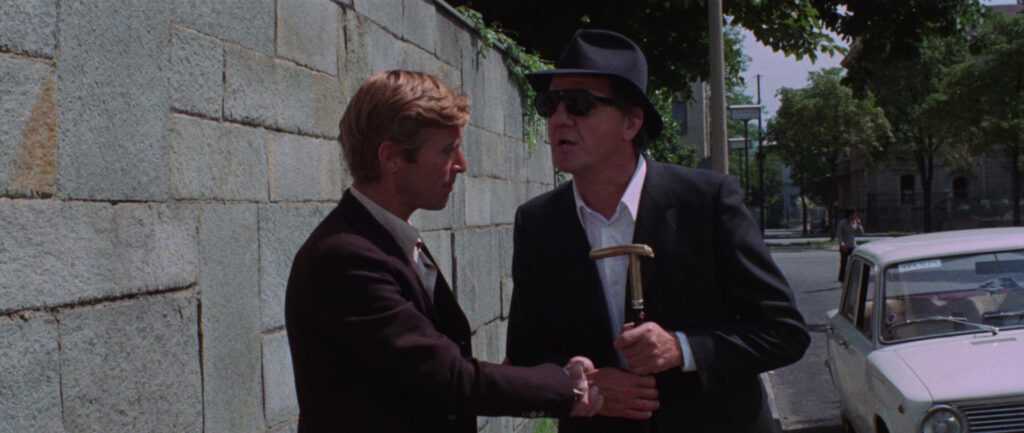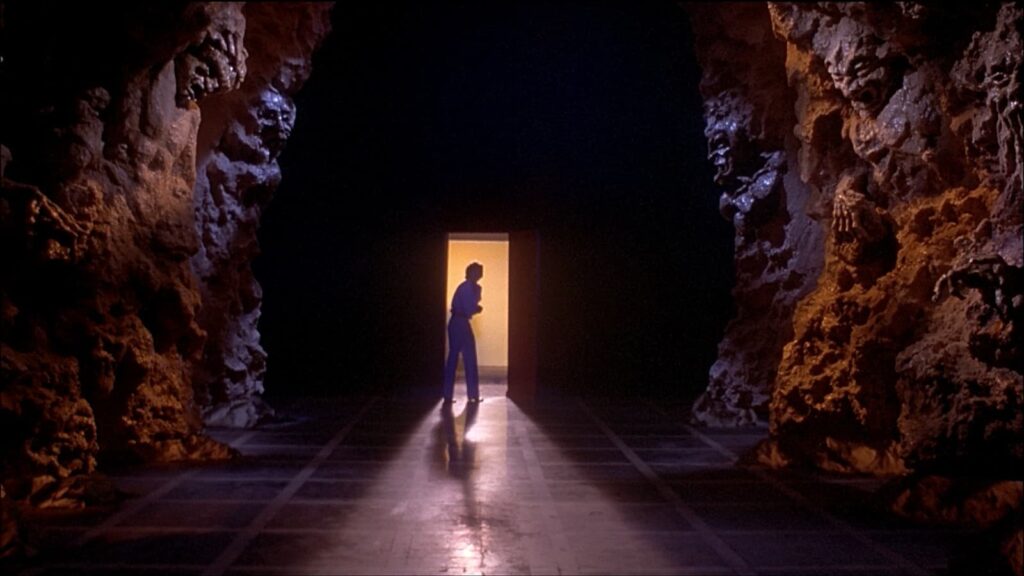Italian horror has become a staple of the Six Weeks of Halloween, with at least one week dedicated to the schlocky cinema of my people. This year, we’ll take a look at three flicks from perhaps the best known Italian horror filmmaker, Dario Argento (as such, he probably doesn’t qualify as an “Obscure Horror Auteur“, another common theme of the 6WH, even if he’s not exactly a household name in America and hasn’t made a notable movie in decades.)
Born to a film producer and a photographer, Argento was always on track to work in the movies and got his start working with the likes of Bernardo Bertolucci and Sergio Leone (even going so far as to earn a Story By credit on Once Upon a Time in the West) before directing his first feature, The Bird With the Crystal Plumage (1970). While not the first Giallo, it was a massive success and it’s generally credited with kicking the sub-genre into high gear. Argento would immediately follow it up with two more Giallos in 1971, creating a sorta unofficial trilogy of unrelated movies tied together by their Animal titles. We’ve covered Argento repeatedly over the last fifteen years of the Six Weeks of Halloween, but there’s still plenty of his filmography (including some heavy hitters) that I have yet to explore, so let’s jump in:
Six Weeks of Halloween: Week 2 – Dario Argento
- Murder Mystery Dinner Party (Robot Chicken)
- Deep Red (trailer)
- Tenebrae (trailer)
The Cat o’ Nine Tails – The second of Argento’s Animal trilogy went into production immediately following the success of The Bird With the Crystal Plumage and is famously one of Argento’s least favorite of his own films (I’m guessing the young director was pressured to crank this sucker out in a rush.) It’s certainly the slowest and most conventional of the three Animal films, a straightforward murder mystery produced in a mostly unflashy manner. This is disappointing coming from a director who basically embodies the concept of style-over-substance, but it’s not entirely without merit either.

In particular, Argento develops an endearing friendship between the two leads, a blind retiree played by Karl Malden (an Oscar winner slumming it in Italy) and young hotshot journalist played James Franciscus (of One of My Wives is Missing fame*), as they investigate a mystery involving a genetics institute (including a plot point that would probably infuriate current day, gender obsessed audiences). Something just clicks when they’re onscreen together, and even the young girl who accompanies Malden most of the time is pretty great in the role. Unfortunately, they split the two leads up often, the film goes on for far, far too long, and the story is too simple to justify that length.
Argento would obviously go on to bigger and better things, even in the same year as this one, as Four Flies on Grey Velvet features more of his visual trademarks, not to mention more unconventional plot elements, and he would go on to perfect the sub-genre with Deep Red (not to mention a few other solid examples of the sub-genre, like Tenebre). That being said, there’s still an element of pulpy fun crafted by a genuine weirdo here. It might be a little slow and go on too long, but it’s still a solid, middle tier Giallo. It’s only really disappointing in light of Argento’s other work in the sub-genre (which is mostly in that top tier). **1/2
- Suspiria (1977) (trailer)
- Suspiria (2018) (trailer)
- The Simpsons: Treehouse of Horror VIII: Easy-Bake Coven (Disney+)
Inferno – This is Argento’s followup to his most famous movie, Suspiria, and much like Cat o’Nine Tails, he’s unable to recapture what made the preceding film so great. It’s still quite stylish and atmospheric, with a couple of bloody and ornate sequences, it just really suffers in comparison to Suspiria.

Argento tries to recapture the visual motifs and primary colors of Suspiria, and it is indeed a visually striking movie. But without Technicolor (which really gave Suspiria a distinct appearance) it just falls a little flatter. Michael Emerson (of Emerson, Lake, & Palmer) takes over the soundtrack duties and does his best (the song Mater Tenebrarum is quite the earworm), but can’t really live up to the iconic Goblin soundtrack from Suspiria. There are several reasonably effective death sequences in the film… but none are as ornate, unique, or memorable as those in Suspiria. The story of Inferno attempts to flesh out the mythology of the Three Mothers, but this basically just amounts to several sequences of interminable and nonsensical exposition, and the film basically just ends with an unresolved whimper. A lot of folks don’t like the more conventional turn in the ending of Suspiria, but once again, I’ll take that over this nonsense any day.
It’s not the worst thing in the world and there’s plenty to like about this, but as a direct sequel, it really suffers in comparison to the first film. Argento had originally planned to do three movies, one for each of the Three Mothers, but didn’t get to the final film until 2007, which was not well received. You’re probably better off just watching Suspiria (and maybe it’s remake). **
- Phantom of the Mall (trailer)
- The Phantom (Robot Chicken)
- The Phantom of the Opera’s Girl Problems (short)
Opera – Ah, now here’s the stuff! By 1987, Argento was moving past the conventions he had previously established while still managing to incorporate all of his calling cards (Black gloved killers! Metal soundtracks! Animals! Voyeurism! Tons of other nonsense!) without seeming repetitive or derivative. It’s probably his last great film, even if he continued to work for decades after.

There are elements of Phantom of the Opera and several other references here, but like Argento’s best work, he plays it a bit fast and loose with the plot while elevating the whole thing with stylistic excess. And boy does this movie engage in stylistic excess. The restless, prowling camera movements, unusual angles, and lavish cinematography are all leveraged to the full extent. It’s the sort of wildly creative style-over-substance that Argento is known for, and it’s all deployed with gusto.
It’s the best thing I watched all week, and it’s certainly the most memorable. He even manages to execute a perfect death scene involving a gun (usually a no-no for this sort of horror), a bravura sequence that rides the line between silly and stylish fun incredibly well. It’s the sort of virtuoso exercise that justifies trawling through a long filmography to find the gems. ***
The intervening decades have not been quite as kind to Argento. His 90s seem filled with moderately well received films, but clearly something was lost, and his more recent works are almost uniformly despised. I may have to check out one of these recent disasters, Dracula 3D, just because I’m still on a bit of a Dracula kick, but I’m not expecting much.
* – Just kidding. One of My Wives Is Missing is one of those obscure TV movies from the seventies that no one has seen, but hey, it’s available on Amazon Prime and is actually pretty fun (if a bit silly).
I really need to rewatch Cat O’Nine Tails. The thing that sticks in my memory the most are the weird triangular milk cartons they use in Italy, randomly enough. I do recall liking Karl Malden.
I wasn’t impressed with Inferno at first either, having the same complaints about it as you. But it’s grown on me with rewatches. It is a really beautiful looking movie and that goes a long way, even if it doesn’t have the characters or scares of Suspiria.
Opera rocks. Those raven POV shots! Definitely Dario’s last capital-G Great movie. Though did you see Black Glasses last year? It was something of a return to form. Maybe the old maestro isn’t quite washed out just yet…
Those triangular milk cartons had me so, so confused at first. What an odd thing.
I can see Inferno being the sort of thing that gets better with subsequent rewatches or even just in your head over time, but I don’t think I’ll be revisiting anytime soon.
I have not seen Dark Glasses, but it’s on Shudder and it seems to have a decent rep… If I’m going to give Dracula 3D a try, might as well give this a shot as well.